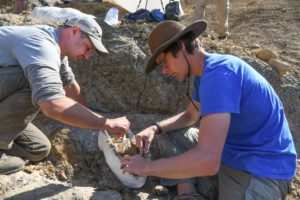
The fossil of an extinct species of sea cow discovered on Santa Rosa Island in 2017 returned to the mainland this week, millions of years after its journey to the island.
The sea cow fossil is conceivably one of the oldest of its kind on the west coast of North America, with an estimated age of 20-25 million years ago.
The sea cow came to rest in shallow seas somewhere near present day San Diego, CA. Over the course of millions of years, it moved when the Pacific Plate, the crust on which the land rests, migrated north and rotated, eventually uplifting the ancient sea floor to a location nearly 1,400 feet above sea level on the remote island.
The fossil specimens will be transferred to the custody and care of Dr. Jonathan Hoffman, a paleontologist with the Santa Barbara Museum of Natural History for collaborative research.
“This sea cow came from a distant place and from an entirely different time period,” said Hoffman. “We hope through our research to learn more about the sea cow’s food sources and the environment in which they lived.”
It took Hoffman and a team of 15 researchers and students from seven different institutions nearly a month to free up the two sea cow specimens. They used chisels, picks, and rock hammers to chip away and detach the head and rib sections from the cement-like rock base.
National Park Service staff crated the specimens, weighing about 500 pounds, for a helicopter air lift to the Bechers Bay pier on Santa Rosa Island for boat transport to Channel Islands National Park headquarters in Ventura Harbor.
Hoffman expects it will take over six months to expose the skull that is encased in rock. Fossil preparators will use dental picks and pneumatic hand drills to carefully expose the fossil for study.
He will enlist Dr. Jorge Velez-Juarbe, a marine mammal taxonomic expert at the Natural History Museum of Los Angeles County, to analyze the sea cow skull for taxonomic identification. Scientists expect the sea cow to be identified as a new species.
United States Geologic Survey scientists will date the sea cow remains using marine microfauna fossils (e.g., snails, clam shells, and crabs) that were collected within the surrounding rock strata.
Scientists will analyze teeth from fossil specimens found nearby to learn more about the sea cow’s diet and environment. Sea cows are known to eat seagrass and their teeth tend to be heavily worn due to the sand they ingest when feeding.
Sea cows, or sirenians (which includes modern manatees and dugongs), are torpedo-shaped aquatic mammals that live in shallow waters and grow to be massive in size, up to 13 feet in length. In some parts of the world, their fossil records date back to 50 million years ago.
At one time, there were over a dozen different genera of sirenians, a name derived from the mermaids of Greek mythology. The cause of their decline is unclear, but may be linked to changes in food availability and environmental and oceanographic conditions.
Their modern relatives include three manatee species in the western hemisphere and the dugong, found in the warm waters of the Pacific Ocean and the east coast of Africa. The dugong is the closest living relative to the sea cow from Santa Rosa Island. The last remaining dugong on the west coast of North America, the Stellar’s sea cow, was hunted to extinction in the 1760s.
